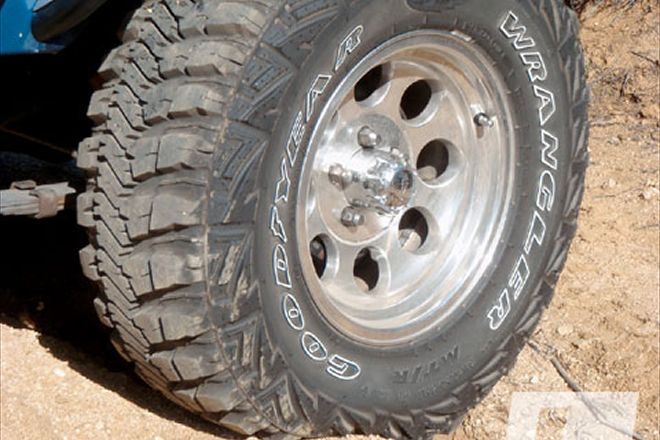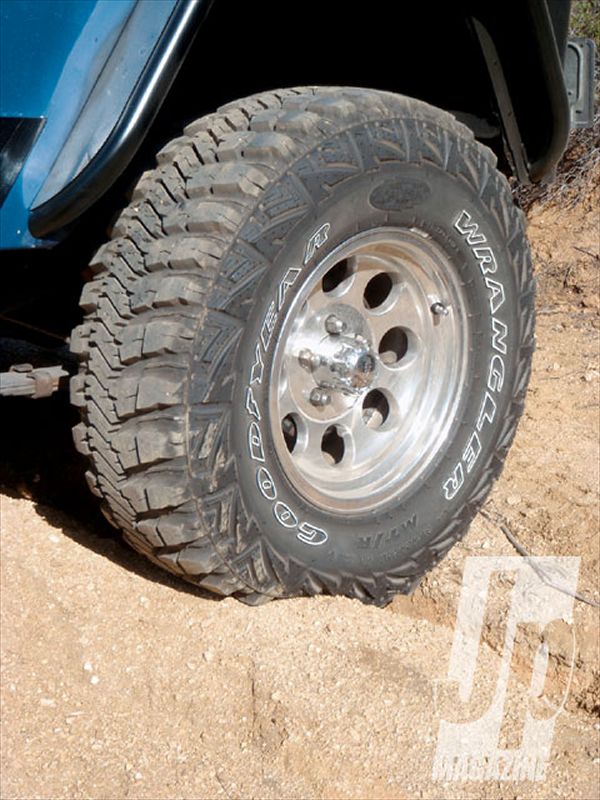
 Pete Trasborg
Brand Manager, Jp
Pete Trasborg
Brand Manager, Jp

Back in the '90s, Goodyear introduced the MT/R name and with it, a radical depar- ture from the other aggressive tires of the time. It balanced well, was quieter than anything else that aggressive, and its construction lent itself to abuse like no radial tire did before. Fast forward a decade, and many Jeepers have come to look at the MT/R as the tire for the Jeep that drives on- and off- road, and many of the MT/R's design features have found their way into other manufacturers' tires.
We aren't going to lie to you guys, at first we were skeptical of the new tread. It just looks so directional, the tightly spaced lugs on 1/4 of the tire must take away from off-road prowess, the outer 1/4 of directional-looking tread on one side of the Jeep just couldn't work as well as they did on the other side of the vehicle, and finally it looked like the company removed rubber from the shoulder lugs (how can that protect the sidewall or provide traction?).
We've never been so happy to be wrong.
Of course the big thing is the Kevlar, such as that found in bulletproof vests and high-tensile strength ropes, and it has been incorporated into the 3-ply sidewalls for 35-percent improved puncture resistance and durability. According to Goodyear, the new tires do better at everything off-road than the old ones, and are just as good on-road. All the press hoopla is well and good, but how does it really perform? Read on.
How They Work
In the three short months since this tire was made available to us, we've beat on it throughout California in Johnson Valley, Truckhaven, Asuza Canyon, Big Bear, and in Moab, Utah. We've wheeled side-by-side with Jeeps shod with the old MT/R and the new tire comes out ahead more often than not.
On-road, they are quieter than the old MT/R, but we haven't hit that magic 10,000-mile number yet with them so we are still reserving long-term judgment. In the rain, we tried to get them to hydroplane with no luck. We aren't saying its plane-proof, but we were surprised after a few highway-speed runs at standing 1/2-inch to 1-inch deep puddles that we had no issues aside from the drag of the water pulling on the steering as it would with any tire.
Off-road we stuck the Jeep in mud pits and purposely slowed down the tires to get them to pack up... we succeeded, but as soon as we blipped the throttle, 3/4 of the tread was clear again, which we attribute to the high void area of that 3/4 of the tire. Then we tried popping the clutch and getting them to dig so we'd hang the differentials up, and they just wouldn't dig, and we think its that tightly-packed portion of the tread that keeps it from digging. At the end of the day, the only way for us to get stuck was to hang the belly skidplate up in the mud. Even with the differential covers plowing mud, we made forward progress
In the sand we did stupid things like going up the blowsand side of the hill, forcing the Jeep to dig itself down, and then we were able to just back out. We were concerned that the seemingly directional look would transfer into directional-type behavior by getting us into something and then not being able to back out. Also, as with the mud, it takes a concentrated effort to get the tires to dig. That tight-packed tread section just doesn't want to allow it. We were able to get it to dig in dunes, by going uphill, popping the clutch, and then staying in the throttle.
In the rocks, we first aired them down to 10psi, and they grabbed rocks very well. Those shoulder lugs we were concerned about worked to hold the Jeep up in V-notches and climb smooth rock faces using just the sidewall of the tire very well. Then, we dropped them to 6psi and just beat on 'em-we did bad things to these tires-50-60mph over a mile of softball sized rocks, pushing hot into corners and basically drifting off-road, and only got so much as a burp out of it when we forced some wood into the bead. We aired it down more, broke the bead, got the wood out, and were good to go. Basically, we were trying to damage that Kevlar sidewall and we did manage to score the rubber, but never punctured it.
Bottom Line
We had the tires mounted by Northridge Tire Pros in Northridge, California, and they took less than 3 ounces per tire to balance with one taking only 1/4-ounce to balance. Of the three tire mounting machines there, they all had a problem with getting the outer bead over the rim, and that's what gave us the assurance to beat them at low pressures as much as we did. Also, these tires run true to size (a 32x11.50R15 really stands 32 inches tall) so you might find you need to put a size smaller on your Jeep for the same fitment.
Goodyear might have been playing with fire by introducing such a radical departure from the old MT/R, but they must have been wearing an asbestos suit, because the company and the tire came out the other side looking and performing better than ever. If you want a mud tire that shines both on- and off-road, this is the tire for you.